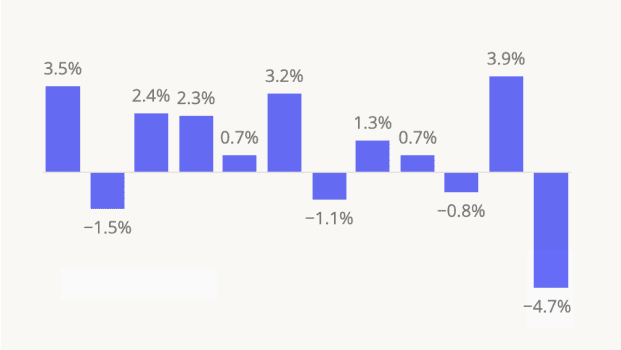About the Placer.ai Mall Index: The Index analyzes data from 100 top-tier indoor malls, 100 open-air shopping centers (not including outlet malls) and 100 outlet malls across the country, in both urban and suburban areas. Placer.ai leverages a panel of tens of millions of devices and utilizes machine learning to make estimations for visits to locations across the country.
January Visits Increase Across Mall Formats
Shopping centers started the year off strong with year-over-year growth across all mall formats analyzed: January 2025 visits increased by 5.5% for indoor malls and by 2.9% and 2.7% for open-air shopping centers and outlet malls, respectively, compared to January 2024. The January visit growth is particularly impressive given this year’s arctic blast which kept many consumers home for much of the month.
January Visit Growth Driven By Increase in One-Off Visits
Relatively few mall-goers visit the mall twice (or more) in one month. Open-air shopping centers have the highest rate of returning monthly visitors – likely thanks to their extensive dining and entertainment options – but even this format only sees around a third of its visitors heading to an open-air shopping center more than once a month.
Comparing the share of returning visitors in January 2024 and 2025 for each format reveals that the share of returning (2+ times) visitors decreased YoY in January 2025, even as overall traffic increased. This means that last month’s visit growth was primarily driven by casual visitors, and could indicate that interest in malls is moving beyond regular patrons as the format now gains new customers – boding well for shopping centers’ potential in 2025.
How Does Mall-Based Consumer Behavior Shift During the Holidays?
Even though January visits increased YoY, traffic was still (expectedly) significantly lower than it was in December. The holidays are malls’ busiest season, and traffic between December 2024 and January 2025 dropped 36.1%, on average, across the three formats. And diving into the data reveals several shifts in audience profile and visitor behavior between December and January.
In terms of visitor behavior, dwell time across the three mall formats fell in January compared to December, indicating that all three shopping center types enjoy an increase in both the quantity and the quality of visits over the holiday season. The increase in dwell time in December seemed correlated with the increase in holiday visits: Outlet malls, which received the largest holiday visit boost, also had the biggest difference in dwell time between December and January (73.8 minutes compared to 68.7 minutes, or a 6.9% increase in dwell time in December). Meanwhile, open-air shopping centers, which received the smallest holiday visit boost, also saw the smallest difference in dwell time between December and January.
In terms of audience profile, the holidays seemed to drive more visits from members of households with children to all mall formats. This is likely due to several factors, including parents looking for a one-stop-shop for their gift lists and to the numerous family-friendly holiday activities offered by malls across the country, such as mall Santas and holiday markets.
2025: The Year of the Mall?
The January 2025 Mall Index data suggests significant growth potential for malls in 2025. The increase in one-off visits may indicate that malls are attracting a broader audience, signaling an opportunity for retailers and shopping centers to convert these casual visitors into loyal customers. Will malls leverage this momentum to ensure that today’s occasional mall-goers become tomorrow’s repeat shoppers?
Visit placer.ai to find out.




.png)
.png)

.png)
.png)














.svg)